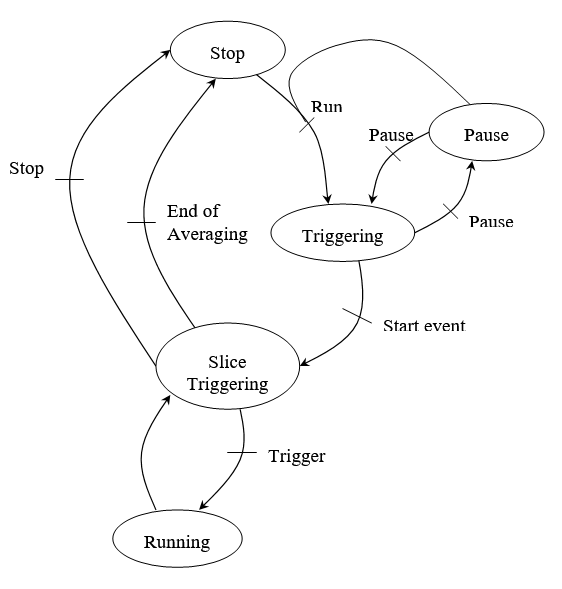NVGate Waterfall
Waterfall
The current plug-in status is synthesized in a special progress-bar. This status bar is automatically displayed in the ’control panel’ when the plug-in is active (i.e. as soon as at least 1 input is connected to the Waterfall plug-in). This status is called ’Waterfall’ and it is available in the status ASB tree (see customize control panel).
This status displays the slice number acquired in the waterfall, the plug-in state (Run, Paused or Stop) and the real-time status.
The way the status bar is displayed, depends on the mode selected:
- ’One shot’ mode: the progress bar is filled from left to right.
- ’Continuous’ mode: the progress bar is filled from right to left with flashing until the end of the acquisition.
- ’Off’ mode: the progress bar is empty with the text ’Off’ inside.
The color of the bar and of the writing let you know what happens during the acquisition:
- Green background and white or black text: acquisition in real time.
- Red background and white or black text: the current acquisition is not real time.
- Green background and red text: the current acquisition is real time, but a previous acquisition was not real time.
Trigger State
The following scheme describes the different states of the measurement:
By default the trigger state is on ’Stop’ and waiting for a ’Run’ (start or trigger). Then the state become ’Triggering’ and is waiting for a start event, the states become ’Block Triggering’ and is now waiting for a trigger event for being in the ’Running state.
The state is ’Stop’ after a stop event or at the end of averaging.
Count
This status displays the averaging count, that total number of slices already acquired.
Real-time
This status displays if the averaging is in real-time or not (i.e. the current block is analyzed or not). If the corresponding signal were not available at this time, the acquisition is not real-time. That means that the treatment is longer than the acquisition. There are three values for this state:
- ’OK’: The acquisition is real-time.
- ’No’: One previous acquisition was not real-time.
- ’-’: The acquisition is currently not real-time.
% Block lost
During an acquisition, results are stocked on the analyzer DSP in a buffer storage (limited to 4 MSample per DSP). If the depth of the waterfall is larger than this, then the PC must empty this buffer storage during acquisition (then the PC can store more results). The DSP to PC transfer takes place as soon as the waterfall acquisition starts depending on connection status (stand alone, poor quality). This process continuously empties the DSP memory. A block is lost if the DSP to PC transfer is not able to get it before the DSP memory is full.
In ’one shot’ mode and for depth smaller than X the acquisition is preferred to the displaying, i.e. the display takes place at the end of acquisition
In ’continuous’ mode or for depth larger than X, the displaying is preferred to the acquisition, in order to see quickly any change during the measurement, some block may be lost.
% Block transferred
This status displays the percentage of block that the PC could have recovered from the DSP buffer storage.
Note that: %Block lost + %Block transferred = 100%.
<references/>

